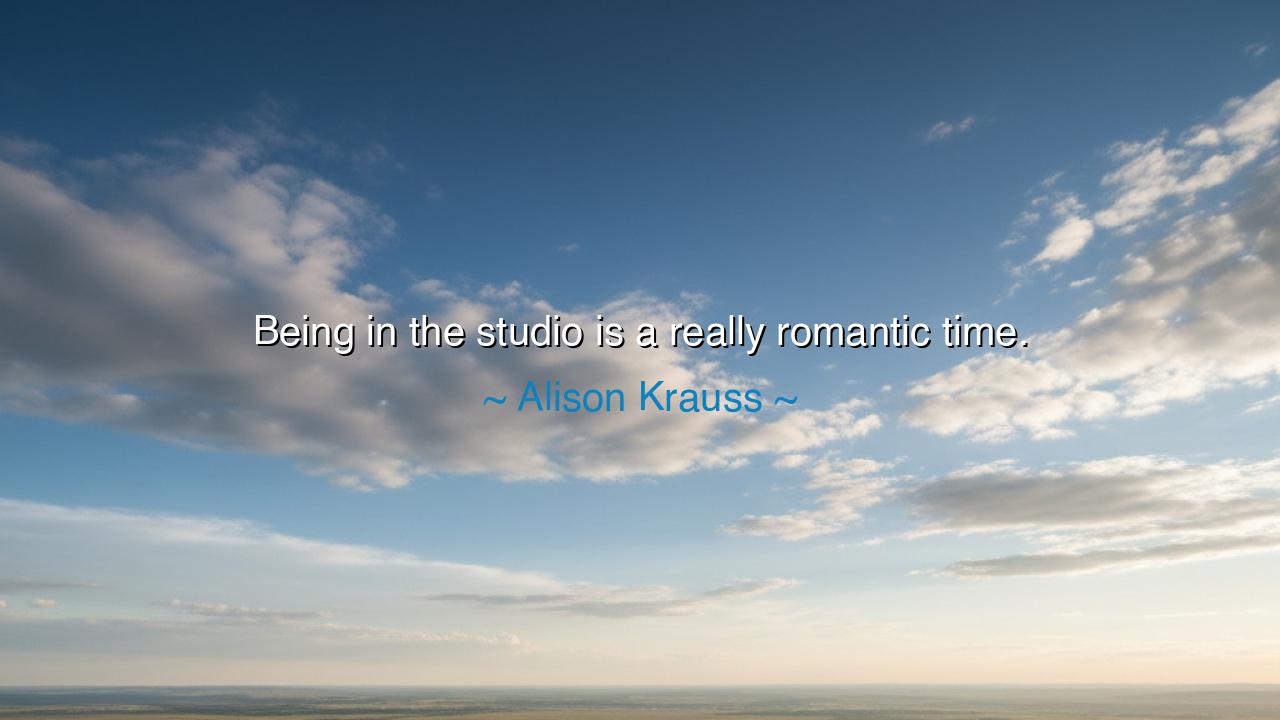
Being in the studio is a really romantic time.






"Being in the studio is a really romantic time." – Alison Krauss. In these words, Krauss captures the essence of creativity and the deeply emotional connection that arises during the act of making art. For Krauss, the studio is more than just a place of work; it is a sanctuary, a space where music flows freely, where the soul is revealed, and where time seems to stand still. The idea of the studio as a romantic space speaks to the intense connection between the artist and their craft, the romance of creation itself. It is in this environment that the artist is free to explore their deepest emotions, to give life to their ideas, and to experience the joy and fulfillment that comes from sharing their inner world with others.
In the ancient world, the act of creation was often viewed as a sacred endeavor. The Greek philosopher Plato believed that art was a means of reaching toward higher truths, a way for the artist to express not only their personal vision but the very essence of divine beauty. The artist, in this sense, was seen as a mediator between the earthly realm and the divine, channeling something transcendent through their work. Much like Krauss’s view of the studio as a romantic place, the act of creation in the ancient world was imbued with a sacredness that elevated the artist beyond the ordinary and into the realm of the divine. The studio, as Krauss describes it, becomes a space of transformation, where mundane reality fades and the artist is free to explore inspiration, emotion, and beauty without restraint.
This romantic connection between the artist and their work is exemplified in the life of Ludwig van Beethoven, the great composer who created some of the most profound music the world has ever known. Beethoven’s studio—his very composition space—was where he wrestled with the deepest complexities of the human soul. His romanticism is evident in his music, especially in pieces like the Ninth Symphony, which reflects both the anguish and ecstasy of the human experience. Despite his growing deafness, Beethoven continued to compose music in his isolated studio, driven by the passion of creation. Like Krauss’s experience, his studio became a sacred space where the romantic impulse of creation came to life, not only as an escape but as a means of connecting with something greater than himself. For Beethoven, the studio was a place where inner turmoil and joy could be transformed into something that transcended the self.
Similarly, the romantic nature of the studio is reflected in the life of Frida Kahlo, the Mexican artist known for her intensely personal and emotional works. Kahlo’s studio was more than just a workspace—it was a reflection of her inner world, where her struggles, triumphs, and passions were transformed into visual art. Her studio, like Krauss’s, was a space where she could immerse herself in the romance of creation, turning pain and suffering into profound artistic expression. Through her work, Kahlo explored the depths of identity, suffering, and love, revealing the romantic tension between the artist and their craft. The act of creating, for Kahlo, was not just a career but a form of emotional liberation, a way to connect with herself and the world in ways that were both personal and universal.
The lesson we take from Krauss’s reflection is that art—in any form—is a deeply romantic endeavor. It is a process of self-expression, where the artist is free to explore the fullness of their emotions, thoughts, and visions. The studio becomes a sanctuary where the world outside fades, and the artist is left to engage in a sacred dialogue with their inner self. Just as the ancients believed that true art comes from the divine, so too does Krauss’s romantic notion of the studio reflect the idea that creation is a form of communication with something greater—whether that be the divine, the collective unconscious, or the soul of humanity.
In our own lives, we should seek to create spaces where we can engage with our own creativity—spaces where we can explore our emotions, express our thoughts, and create something that reflects our innermost selves. Whether it is through music, painting, writing, or any other form of artistic expression, we must embrace the romantic nature of creation and allow ourselves to fully immerse in the act of creation. The studio, whether physical or metaphorical, is a place where we can connect with our deepest emotions and transform them into something meaningful.
Thus, let us all find our own studio, a space where we can create freely, without judgment, and allow the romance of creation to lead us to new discoveries and personal growth. By embracing the romantic nature of artistic expression, we allow ourselves to be transformed, just as Krauss and countless artists before her have been. Through this process, we not only create art, but also a deeper connection with ourselves, others, and the world around us. Just as the studio is sacred to the artist, so too should our creative spaces be sanctuaries where we find freedom, beauty, and expression in every form.






AAdministratorAdministrator
Welcome, honored guests. Please leave a comment, we will respond soon